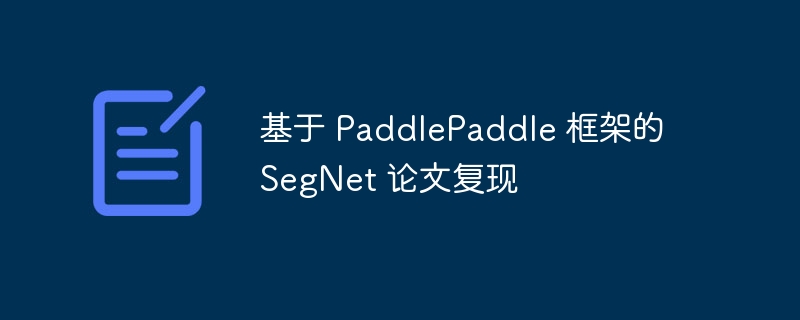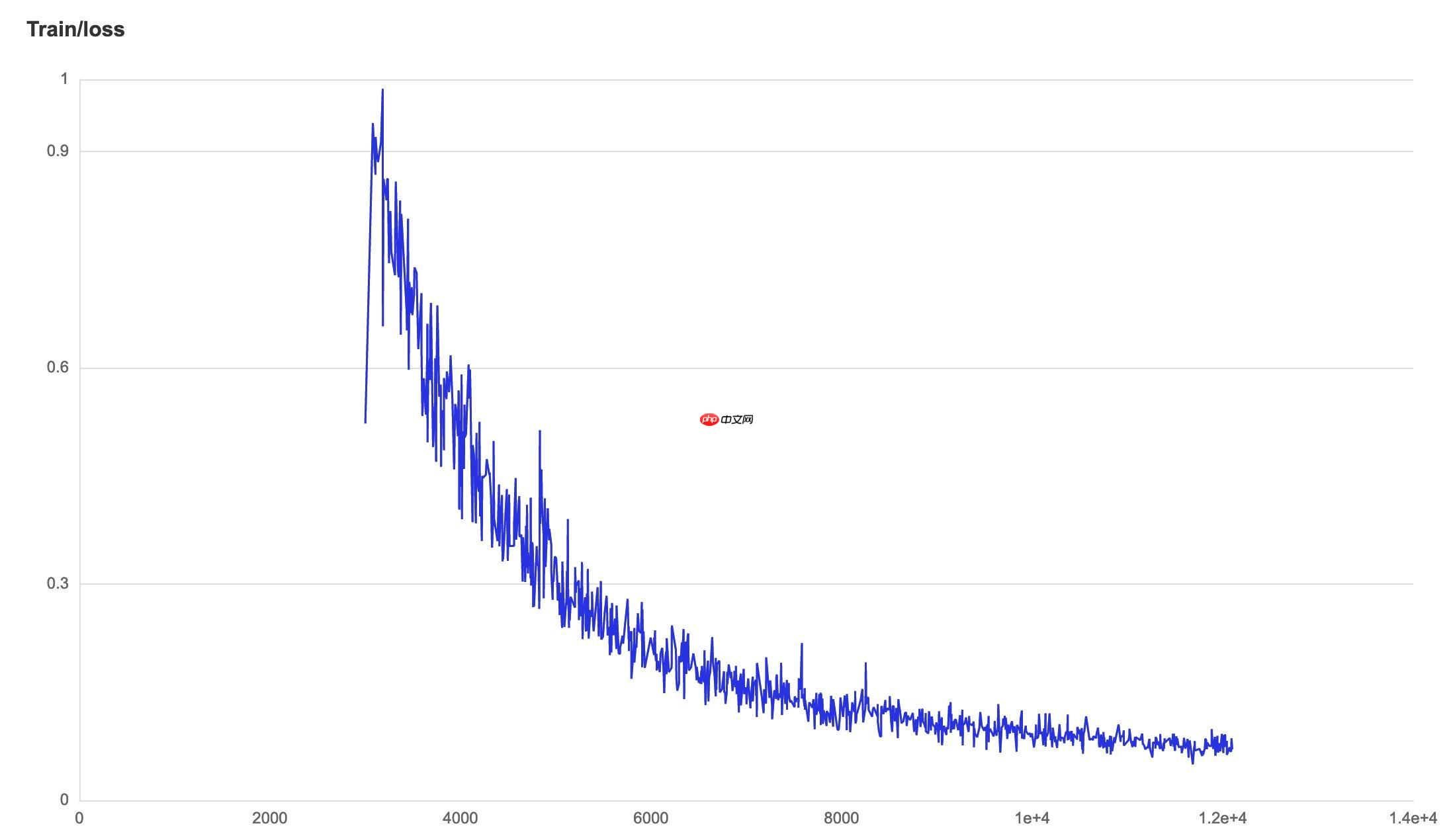基于 PaddlePaddle 框架的 SegNet 论文复现
发布时间:2025-07-18 编辑:游乐网
本文复现了SegNet语义分割模型,其为编码器-解码器结构,编码器对应VGG-16前13层,解码器共13层,损失函数采用带median frequency weight的加权交叉熵。在Ai Studio环境配置后,基于PaddleSeg,经模型搭建、损失函数设计及调参,在camvid数据集上复现,结果超原论文60.1%的mIoU精度。

论文简介
论文名称:SegNet: A Deep Convolutional Encoder-Decoder Architecture for Image Segmentation
论文地址:https://arxiv.org/pdf/1511.00561.pdf
1. 网络结构

总体结构是一个“编码器——解码器”最后加上Softmax层的结构
编码器与VGG-16的前13层,相对应的,解码器也是13层
2. Loss
使用的是交叉熵函数
原论文使用的是“median frequency weight”的加权交叉熵进行计算,每一类的 weight=median(weights)/weights
实验时我们同时使用了不加权重的交叉熵和加权重的交叉熵进行计算,发现加权重的交叉熵效果的确更好
3. Experiments
3.1 Ai Studio 环境配置
由于 Ai Studio 的部分兼容问题,目前使用加权交叉熵需要修改 PaddlePaddle 内置的交叉熵函数,可以在终端中执行如下命令进行暂时的修复:
1.使用 vim 编辑文件:
vim /opt/conda/envs/python35-paddle120-env/lib/python3.7/site-packages/paddle/nn/functional/loss.py
2.注释掉问题语句:
:1414,1420s/^/#/g
之后就可以使用 Ai Studio 环境进行复现
3.2 训练、验证参数设置
在 config.yml 中可以对训练、验证参数进行设置
batch_size: 12 #设定batch_size的值即为迭代一次送入网络的图片数量,一般显卡显存越大,batch_size的值可以越大iters: 1000 #模型迭代的次数train_dataset: #训练数据设置 type: Dataset #选择数据集格式 dataset_root: data/PaddleSeg/camvid #选择数据集路径 train_path: data/PaddleSeg/camvid/train_list.txt #选择数据集list num_classes: 12 #指定目标的类别个数(背景也算为一类) transforms: #数据预处理/增强的方式 - type: Resize #送入网络之前需要进行resize target_size: [512, 512] #将原图resize成512*512在送入网络 - type: RandomHorizontalFlip #采用水平反转的方式进行数据增强 - type: Normalize #图像进行归一化 mode: trainval_dataset: #验证数据设置 type: Dataset #选择数据集格式 dataset_root: data/PaddleSeg/camvid #选择数据集路径 val_path: data/PaddleSeg/camvid/val_list.txt #选择数据集list num_classes: 12 #指定目标的类别个数(背景也算为一类) transforms: #数据预处理/增强的方式 - type: Resize #将原图resize成512*512在送入网络 target_size: [512, 512] #将原图resize成512*512在送入网络 - type: Normalize #图像进行归一化 mode: valoptimizer: #设定优化器的类型 type: sgd #采用SGD(Stochastic Gradient Descent)随机梯度下降方法为优化器 momentum: 0.9 #动量 weight_decay: 4.0e-5 #权值衰减,使用的目的是防止过拟合learning_rate: #设定学习率 value: 0.1 #初始学习率 decay: type: poly #采用poly作为学习率衰减方式。 power: 0.9 #衰减率 end_lr: 0 #最终学习率loss: #设定损失函数的类型 types: - type: CrossEntropyLoss #损失函数类型 coef: [1]model: #模型说明 type: SegNet #设定模型类别 num_classes: 12登录后复制
3.3 开始训练
快速开始命令介绍:
cd PaddleSegpython train.py \ # 使用 PaddleSeg 进行训练 --config config.yml \ # 配置文件路径 --do_eval \ # 在保存模型时验证 --use_vdl \ # 使用 visualdl 保存日志 --save_interval 500 \ # 保存模型的频率 --save_dir output # 模型及日志保存路径登录后复制
3.4 训练过程展示
训练日志可以在 github 项目下载:https://github.com/stuartchen1949/segnet_paddle/tree/main/log_upload
下面截取部分信息展示:

3.5 调参技巧说明
最好是按照原论文的超参数进行复现,这样工作量低
在本论文中,bs=12,lr=0.1,使用 SGD 方法,动量为0.9 但是也可以另辟蹊径,比如:分阶段训练,每个阶段设置学习率不同
3.6 其他说明
截至2024年8月18日,在解码器的 unpool 过程中,Paddle 并无对应的 API,所以在本次复现使用的是 Paddle 的 interpolate 函数,插值方式设置的是“双三次插值”
项目介绍
项目背景
本项目为“飞桨论文复现挑战赛(第四期)”参赛作品,比赛链接:https://aistudio.baidu.com/aistudio/competition/detail/106
目的是复现论文“SegNet: A Deep Convolutional Encoder-Decoder Architecture for Image Segmentation”
项目结果

结果说明
原论文使用“camvid 11类”数据集达到 miou 精度 60.1% ,我们的结果为 0.5553/11*12=0.605 >60.1% (因为最后一类是void,原论文并未计算,需要消除这个影响)
项目实现思路
大方向
1.模型搭建
2.损失函数设计
3.调参
模型搭建
由于属于 语义分割 问题,故使用 Paddle 的 PaddleSeg 模块进行快速开发
PaddleSeg 快速指南:https://github.com/PaddlePaddle/PaddleSeg/blob/release/2.2/docs/quick_start.md
为了实现复现任务,我们只需要:
1.定义模型并添加至 PaddleSeg 的模型库中
2.计算出交叉熵的权值并修改 PaddleSeg 的 交叉熵函数.py
3.创建 config.py 文件设置超参数
损失函数设计
原论文使用的是“median frequency weight”的加权交叉熵进行计算,每一类的 weight=median(weights)/weights
调参
按照原论文的数据进行设置即可
我们使用的 config.yml 文件内容如下
batch_size: 12iters: 10000train_dataset: type: Dataset dataset_root: PaddleSeg/camvid train_path: PaddleSeg/camvid/train_list.txt num_classes: 12 transforms: # - type: Resize # target_size: [512, 512] # - type: RandomHorizontalFlip - type: Normalize mode: trainval_dataset: type: Dataset dataset_root: PaddleSeg/camvid val_path: PaddleSeg/camvid/val_list.txt num_classes: 12 transforms: # - type: Resize # target_size: [512, 512] - type: Normalize mode: valoptimizer: type: sgd momentum: 0.9 weight_decay: 4.0e-5lr_scheduler: type: PolynomialDecay learning_rate: 0.1 end_lr: 0 power: 0.9loss: types: - type: CrossEntropyLoss coef: [1]model: type: SegNet num_classes: 12登录后复制
我们需要修改 PaddleSeg 中的损失函数 cross_entropy_loss.py ,修改后如下
import paddlefrom paddle import nnimport paddle.nn.functional as Ffrom paddleseg.cvlibs import manager@manager.LOSSES.add_componentclass CrossEntropyLoss(nn.Layer): """ Implements the cross entropy loss function. Args: weight (tuple|list|ndarray|Tensor, optional): A manual rescaling weight given to each class. Its length must be equal to the number of classes. Default ``None``. ignore_index (int64, optional): Specifies a target value that is ignored and does not contribute to the input gradient. Default ``255``. top_k_percent_pixels (float, optional): the value lies in [0.0, 1.0]. When its value < 1.0, only compute the loss for the top k percent pixels (e.g., the top 20% pixels). This is useful for hard pixel mining. Default ``1.0``. data_format (str, optional): The tensor format to use, 'NCHW' or 'NHWC'. Default ``'NCHW'``. """ def __init__(self, weight= # None, # [0.49470329175952255, # 0.35828960644888747, # 8.478075684728779, # 0.2632281509876036, # 1.8575191953843206, # 0.8569813461262166, # 7.10457223748049, # 7.395517740818225, # 1.4206921357883606, # 13.036496170307238, # 28.57158303913671, # # 2.1105473453421433 # 0], [0.5183676152953121, 0.3754285285214713, 8.883627718253265, 0.2758197715255286, 1.946374345422177, 0.8979753806852697, 7.444422201714914, 7.749285195873823, 1.4886514942686155, 13.660102013013443, 29.938315778195324, 0], ignore_index=11, top_k_percent_pixels=1.0, data_format='NCHW'): super(CrossEntropyLoss, self).__init__() # if weight is not None: # weight = paddle.to_tensor(weight, dtype='float32') if weight is not None: self.weight = paddle.to_tensor(weight, dtype='float32') long_weight = weight + [0] * (256 - len(weight)) self.long_weight = paddle.to_tensor(long_weight, dtype='float32') else: self.weight = None self.long_weight = None # self.weight = weight self.ignore_index = 11 self.top_k_percent_pixels = top_k_percent_pixels self.EPS = 1e-8 self.data_format = data_format def forward(self, logit, label, semantic_weights=None): """ Forward computation. Args: logit (Tensor): Logit tensor, the data type is float32, float64. Shape is (N, C), where C is number of classes, and if shape is more than 2D, this is (N, C, D1, D2,..., Dk), k >= 1. label (Tensor): Label tensor, the data type is int64. Shape is (N), where each value is 0 <= label[i] <= C-1, and if shape is more than 2D, this is (N, D1, D2,..., Dk), k >= 1. semantic_weights (Tensor, optional): Weights about loss for each pixels, shape is the same as label. Default: None. """ channel_axis = 1 if self.data_format == 'NCHW' else -1 if self.weight is not None and logit.shape[channel_axis] != len( self.weight): raise ValueError( 'The number of weights = {} must be the same as the number of classes = {}.' .format(len(self.weight), logit.shape[1])) logit = paddle.transpose(logit, [0, 2, 3, 1]) # logit = paddle.transpose(logit, [0, 2, 1]) loss = F.cross_entropy( logit, label, ignore_index=self.ignore_index, reduction='none', # weight=self.weight weight=self.long_weight) mask = label != self.ignore_index mask = paddle.cast(mask, 'float32') loss = loss * mask if semantic_weights is not None: loss = loss * semantic_weights if self.weight is not None: _one_hot = F.one_hot(label, logit.shape[-1]) coef = paddle.sum(_one_hot * self.weight, axis=-1) else: coef = paddle.ones_like(label) label.stop_gradient = True mask.stop_gradient = True if self.top_k_percent_pixels == 1.0: avg_loss = paddle.mean(loss) / (paddle.mean(mask * coef) + self.EPS) return avg_loss loss = loss.reshape((-1, )) top_k_pixels = int(self.top_k_percent_pixels * loss.numel()) loss, indices = paddle.topk(loss, top_k_pixels) coef = coef.reshape((-1, )) coef = paddle.gather(coef, indices) coef.stop_gradient = True return loss.mean() / (paddle.mean(coef) + self.EPS)登录后复制 添加我们的模型
1. 将 my_model.py 拷贝至 PaddleSeg/paddleseg/model
2. 修改 __init__.py
项目使用
本项目基于 PaddleSeg 开发,所以使用过程简单,下面进行逐步介绍
0. 解压数据集并进行预处理
1. 下载 PaddleSeg
2. 将相应配置文件修改(本项目采用 cp 命令直接对原文件进行覆盖)
3. 运行训练即可
4. 运行验证即可
0. 解压数据集并进行预处理
In [ ]# 解压数据!unzip -oq /home/aistudio/data/data79232/camvid.zip登录后复制 In [ ]
# 创建listimport osdir = "camvid"%cd camvid!touch train_list.txt!touch val_list.txt%cdnames = os.listdir(os.path.join(dir, "train"))l = len(names)print("总共%d个数据" %l)n = 0for name in names: with open("camvid/train_list.txt","r+") as f: f.read() # t = "camvid/train/" + name + " camvid/trainannot/" + name + "\n" t = "train/" + name + " trainannot/" + name + "\n" f.write(t) n+=1 # with open("train_list.txt","r+") as f: # f.read() # t = "camvid/train/" + name + " camvid/trainannot/" + name + "\n" # f.write(t) # n+=1 print("已写入%d路径" %n)dir = "camvid"names = os.listdir(os.path.join(dir, "val"))l = len(names)print("总共%d个数据" %l)n = 0for name in names: with open("camvid/val_list.txt","r+") as f: f.read() # t = "camvid/val/" + name + " camvid/valannot/" + name + "\n" t = "val/" + name + " valannot/" + name + "\n" f.write(t) n+=1 # with open("val_list.txt","r+") as f: # f.read() # t = "camvid/val/" + name + " camvid/valannot/" + name + "\n" # f.write(t) # n+=1 print("已写入%d路径" %n)dir = "camvid"# %cd camvid!touch train_list.txt# !touch val_list.txt# %cdnames = os.listdir(os.path.join(dir, "train"))l = len(names)print("总共%d个数据" %l)n = 0for name in names: with open("train_list.txt","r+") as f: f.read() t = "camvid/train/" + name + " camvid/trainannot/" + name + "\n" f.write(t) n+=1 print("已写入%d路径" %n)登录后复制 In [ ]# 平衡数据集 lossimport cv2 as cvimport numpy as nppaths = open("train_list.txt", "r")CLASS_NUM = 11SUM = [[] for i in range(CLASS_NUM)]SUM_ = 0for line in paths: line.rstrip("\n") line.lstrip("\n") path = line.split() img = cv.imread(path[1], 0) img_np = np.array(img) for i in range(CLASS_NUM): SUM[i].append(np.sum((img_np == i)))for index, iter in enumerate(SUM): print("类别{}的数量:".format(index), sum(iter))for iter in SUM: SUM_ += sum(iter)median = 1/CLASS_NUMfor index, iter in enumerate(SUM): print("weight_{}:".format(index), median/(sum(iter)/SUM_))登录后复制 1. 下载 PaddleSeg
In [ ]# 安装 paddleseg!git clone https://gitee.com/paddlepaddle/PaddleSeg.git!pip install PaddleSeg登录后复制
2. 将相应配置文件修改(本项目采用 cp 命令直接对原文件进行覆盖)
In [ ]# 覆写损失函数!cp cross_entropy_loss.py PaddleSeg/paddleseg/models/losses/# 添加自定义 model!cp my_model.py PaddleSeg/paddleseg/models!cp __init__.py PaddleSeg/paddleseg/models登录后复制
3. 运行训练即可
In [ ]# 训练一 3000 iter ,模型保存至output!python PaddleSeg/train.py \ --config config.yml \ --do_eval \ --use_vdl \ --save_interval 100 \ --log_iters 1 \ --save_dir output \ --iters 3000 \ --keep_checkpoint_max 10 \ --batch_size 12登录后复制 In [ ]
# 训练二 36000 iter (只训练到了12111),从output读取模型,保存至output1!python PaddleSeg/train.py \ --config config.yml \ --do_eval \ --use_vdl \ --save_interval 1 \ --log_iters 1 \ --save_dir output_1 \ --iters 36000 \ --keep_checkpoint_max 10 \ --resume_model output/iter_3000 \ --batch_size 12登录后复制
4. 运行验证即可
In [ ]# 计算miou,选取output1最好模型!python PaddleSeg/val.py \ --config config.yml \ --model_path output_1/best_model/model.pdparams # --model_path model.pdparams # 复制到/home/aistudio文件夹了登录后复制
相关阅读
MORE
+- 用豆包AI实现自动化报告?数据分析结果可视化 07-19 从零开始,搭建基于PaddlePaddle图像分割模型的Web应用 07-18
- Claude怎么输入代码让它理解 正确格式和说明技巧解析 07-18 豆包AI怎么调试程序 豆包AI程序调试步骤 07-18
- MicrosoftOfficeExcel怎么进行数据分析 07-18 豆包回答不准确怎么提高准确率的提问技巧分享 07-18
- 用豆包AI生成Python游戏开发代码 07-18 豆包AI编程操作教程 豆包AI自动编程方法 07-18
- EasyEdge:PaddleX 2.0动态图检测模型的部署 07-18 PointPillars:基于点云的3D快速目标检测网络 07-18
- 抠像任务:基于飞桨复现BackgroundMattingV2模型 07-18 Claude如何优化长文本处理 Claude大文档分块解析技巧 07-18
- 去除摩尔纹,治愈强迫症, 来卷网盘赛,榜评0.55623 07-18 豆包AI编程技巧分享 豆包AI开发工具使用 07-18
- DeepSeek能不能帮我写代码 简单编程任务如何交给DeepSeek完成 07-18 豆包AI怎么验证算法 豆包AI算法验证技巧 07-18
- 【第五期论文复现赛-语义分割】ENCNet 07-17 百度网盘AI大赛:手写文字擦除(赛题二)Baseline 07-17




























 湘公网安备
43070202000716号
湘公网安备
43070202000716号